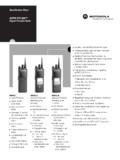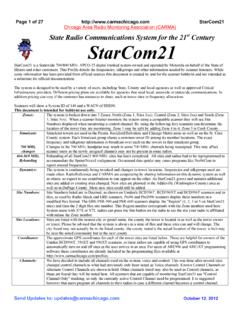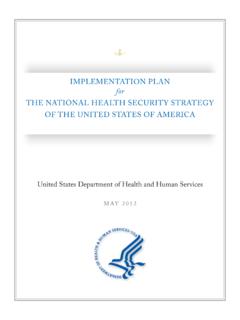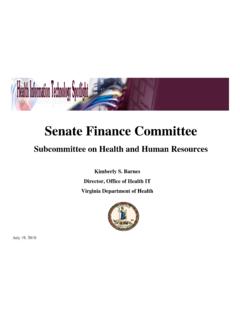Transcription of ALMR FREQUENTLY ASKED QUESTIONS - Alaska …
1 20110927_ALMR/SATS FAQsV3 1 ALMR FREQUENTLY ASKED QUESTIONS WHAT IS A LAND MOBILE RADIO SYSTEM? .. 2 WHAT IS THE Alaska LAND MOBILE RADIO (ALMR) SYSTEM? .. 2 WHY DO WE NEED A LAND MOBILE RADIO SYSTEM? .. 2 WHAT DOES INTEROPERABILITY MEAN? .. 2 IS THERE A FEDERAL REQUIREMENT TO DEVELOP AN INTEROPERABLE SYSTEM? .. 2 HOW ARE WE GOING TO HELP PARTS OF Alaska NOT USING ALMR? .. 3 WHAT IS A TRUNKED LAND MOBILE RADIO SYSTEM? .. 3 WHY IS THE ALMR SYSTEM IMPORTANT? .. 3 WHY CAN T WE CONTINUE USING THE CURRENT APPROACH AND SYSTEMS INSTEAD OF CHANGING TO THE ALMR SYSTEM? .. 3 WHY NOT USE FIBER OPTIC CONNECTIVITY INSTEAD OF MICROWAVE? .. 4 WHY NOT USE SATELLITES INSTEAD OF MICROWAVE TOWERS? .. 4 WHY NOT HAVE EVERYONE USE GATEWAYS? .. 4 WHAT HAPPENS IF THE ALMR IS NOT SUCCESSFUL?
2 4 DOES THE Alaska MARINE HIGHWAY SYSTEM (AMHS) AND THE COAST GUARD USE ALMR? .. 5 ARE OTHER STATES USING LMR? .. 6 DO ALMR RADIOS WORK ON SYSTEMS OUTSIDE Alaska ? .. 6 WHAT WILL HAPPEN IF COMMUNITIES DO NOT PARTICIPATE? .. 7 WHAT IS THE COST OF NOT PARTICIPATING? .. 7 WHAT HAPPENS IF WE FISCALLY SUPPORT ALMR TODAY AND IT IS NOT SUPPORTED IN FUTURE YEARS? IS THE MONEY COMMITTED TODAY WASTED? .. 7 WHAT DOES FEDERAL GOVERNMENT IS MANDATED TO GO TO NARROW BAND MEAN? .. 7 WHAT DOES BACKWARD COMPATIBLE MEAN AND WHY IS THAT CONCEPT IMPORTANT FOR THE ALMR SYSTEM? .. 7 WHAT communication STANDARD WILL WE USE FOR THE ALMR SYSTEM? .. 7 WHY USE A STANDARD? .. 8 WHAT IS TECHNOLOGICALLY POSSIBLE FOR AN LMR SYSTEM, WHEN WE CHANGE TO NARROW BAND FREQUENCIES AND DIGITAL COMMUNICATIONS?
3 8 WHAT DID THE CONCEPT DEMONSTRATION PROVIDE DURING THE ALMR SYSTEM TEST? .. 8 WHAT IS SATS (STATE OF Alaska TELECOMMUNICATIONS SYSTEM)? .. 9 WHO USES SATS? .. 9 20110927_ALMR/SATS FAQsV3 2 WHAT IS A LAND MOBILE RADIO SYSTEM? It is the two-way radio system in use today by first responders and public safety officials for instant, effective, and private communications during everyday operation, and also provides the efficiency, security and flexibility required during emergencies for secure, communications on demand and in real time. WHAT IS THE Alaska LAND MOBILE RADIO (ALMR) SYSTEM? Understanding the answer to this question requires one to understand the cooperative relationship enjoined by the participating federal, state and local public safety entities.
4 That is, that State of Alaska (SOA), Alaska Municipal League, Federal DOD and Federal Non- DOD partnered to address the requirement for security and interoperability, identified a solution and established a migration path to that solution. The objectives of the cooperative is to promote system development by sharing existing resources, burden sharing system costs for operations that maximizes economies of scale, and initiates consolidated procurement and maintenance activities. The result is the ALMR System, which provides the needed communications capability for State, local and federal first responders and public safety entities in Alaska , through an integrated wireless network, that is secure and interoperable, that is cost effective and technologically sound.
5 WHY DO WE NEED A LAND MOBILE RADIO SYSTEM? This is a complicated question , but essentially, it is currently the way first responders and public safety officials communicate. The reason that public safety first responders use LMR systems is because they provide a private dedicated wireless communications capability in mobile environments where these agencies primarily operate. The use of other systems such as cellular and the public telephone does not provide by law, the priority and security required by first responders in public safety roles. WHAT DOES INTEROPERABILITY MEAN? Interoperability has many meanings, but the most basic as defined by the Federal Communications Commission (FCC) is an essential communications link within public safety and public service wireless communications systems which permits units from two or more different entities to interact with one another and to exchange information according to a prescribed method in order to achieve predictable results.
6 Public safety entities engage in three types of interoperability, day-to-day, mutual aid and task force interoperability. IS THERE A FEDERAL REQUIREMENT TO DEVELOP AN INTEROPERABLE SYSTEM? All states were required under the Federal FY 2007 Homeland Security Grant Program to develop and adopt statewide communications interoperability plans by December 2007. The SOA submitted a grant request under the Public Safety Interoperable Communications (PSIC) grant program through the Department of Military and Veterans Affairs (DMVA). This program, administered by the National Telecommunications and Information Administration (NTIA) and the Federal Emergency Management Agency, National Preparedness Directorate requires that interoperability be addressed on a statewide basis.
7 The ALMR System is not a statewide system, but it does cover Alaska s highway system and population centers. 20110927_ALMR/SATS FAQsV3 3 HOW ARE WE GOING TO HELP PARTS OF Alaska NOT USING ALMR? Currently, the ALMR coverage footprint is primarily in the Interior, Southcentral and Southeast areas of the state. For areas of Alaska not currently within ALMR coverage, the SOA DMVA has coordinated with state and local agencies to develop a plan to address the interoperability needs of those areas. WHAT IS A TRUNKED LAND MOBILE RADIO SYSTEM? In two-way radio communications, trunking refers to the automatic sharing of a small number of radio channels between a large numbers of radio users. A trunking system efficiently distributes message traffic among the available channels and reduces channel waiting time.
8 WHY IS THE ALMR SYSTEM IMPORTANT? ALMR provides a single, shared and secure interoperable communications system for all emergency responders along the State s road corridors: SOA, local municipalities, DOD and Federal non-DOD agencies. ALMR satisfies mission and role requirements for 9/11, Homeland Defense, Homeland Security and Defense assistance. ALMR meets the day-to-day needs for all participating agencies. Day-to-day ALMR system use generates the knowledge and expertise of system use when needed for an emergency that requires interoperability across various agencies/jurisdictions. Satisfies FCC mandated Narrow Band requirements for 2012 within ALMR footprint. The ALMR system generates cost efficiencies for all agency users by providing an interoperable communications system that meets dual demands for day-to-day use as well as for higher levels of emergency response and incident command.
9 The ALMR consortium structure generates cost efficiencies for operations and maintenance. WHY CAN T WE CONTINUE USING THE CURRENT APPROACH AND SYSTEMS INSTEAD OF CHANGING TO THE ALMR SYSTEM? You can. However, it will continue to be inefficient, and interoperability between first responders will continue to be severely handicapped. The State and local governments had to move to a new system that supports narrow band technology and public safety communications standards by Dec 31, 2012, to meet the FCC mandate. The SOA system was over 25 years old, and was in need of replacement when replaced by the ALMR trunked technology. This was an opportunity to implement a cost shared, standards based, communication solution that allows most public safety responders from all levels of government to have interoperable communications for day to day use, when mutual aid is required such as during natural and manmade disasters, and during task force operations such as homeland security roles and missions.
10 It ensures the State and local government Public Safety agencies are in compliance with the FCC narrowband mandate, as well as with the DHS National Emergency Communications Plan (NECP). 20110927_ALMR/SATS FAQsV3 4 WHY NOT USE FIBER OPTIC CONNECTIVITY INSTEAD OF MICROWAVE? Fiber optic connectivity has some potential advantages over microwave technology to link ALMR sites. However, many of the current ALMR sites are constructed in areas without access to existing fiber optic cable. Additionally, using existing sites and infrastructure has substantially reduced the overall costs of implementing ALMR. Operating the ALMR system on the existing State of Alaska Telecommunications Systems (SATS) microwave backbone also provides a stand-alone communication system unencumbered by commercial traffic.






